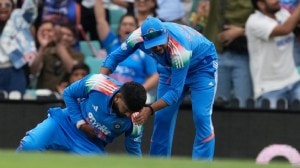Bridge over river Tawi
From a Kiplingesque Jammu neither the LoC nor the Kashmir Valley is far. As ceasefire silenced guns relatives started hugging each other wit...

From a Kiplingesque Jammu neither the LoC nor the Kashmir Valley is far. As ceasefire silenced guns relatives started hugging each other without that familiar fear of a bullet whistling past their ears. Indo-Pak generals went around asking whether to salute or handshake the thaw as migratory birds from Siberia swooped to the Dal Lake despite a separatist bandh call.
Bells at the Raghunath temple still ring — reminding visitors of the bloodshed almost a year back or the mayhem at the Jammu railway station a week ago — probably chiming peace this time. Outside, the narrow lanes of Raghunath Mandir Chowk show the microcosm of life in J&K. As sandbag-laden mules negotiate the steep climb, the dry-fruit and carpet sellers’ calls, offering discounts for the winter, echo in the winter air.
The mountain goats on the riverside don’t seem too bothered about Pakistan’s shift on Kashmir. Neither do their owners, the tall Gujjars or Bakerwals. All they want, like everyone else, is an employment-laden slice from the Indo-Pak peace cake.
On buses plying over Tawi bridge devout travellers bow to a temple on the riverbank. Next to it is a dargah. So the bow that begins at the temple usually ends in front of the dargah — courtesy the moving bus. Upstream, the mighty Trikuta Hills rise over the town, beckoning visitors to the Vaishno Devi shrine. One of Jammu’s oldest gurdwaras faces the Raghunath temple as shabath kirtans mingle with church bells at the other end of town. The Hindu shopkeeper with lithographs of Hindu gods and goddesses writes bills in Urdu as Muslim pithoos carry Hindu devotees to the Vaishno Devi shrine.
Ladakh remains the same — in silent dignity. As wind from the Valley sways the walnut leaves, eucalyptus leaves in the land of Dogras quiver too.
Expectations rise in anticipation as endless factions of the Hurriyat split hair trying to untie the knot that the idea of separation has landed them in, which refuses to accept that Jammu and Kashmir is India in microcosm.
Even the effervescent general, after a very warm summit and two attempts on his life, accepts that threats are mostly imaginary and exist within. A VJ on Geo TV doesn’t look much different from those hailing from some Mumbai suburb — nor does the diesel lubricant ad on PTV seem very different from a Santa-Banta ad in a lush-green Punjab village on this side of the border.
Only the LoC between hearts and minds seems vast. Can a zillion kilometres of barbed wire fencing separate similarities? Probably it’s time for many on the other side of the border to see how the world’s largest democracy works. They need a road trip from Kashmir to Kanyakumari, from Surat to Mokokchong to realise what binds one billion people who are diverse enough and yet willing to die for one nation.



- 01
- 02
- 03
- 04
- 05




























